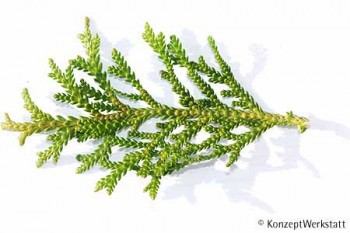Thujopsis (pronounced "Thuyopsis"), as described by (Carl Peter Thunberg ex Carolus Linnaeus f.), is a conifer in the cypress family (Cupressaceae); the sole member of the genus being Thujopsis dolabrata. It was actually first described as Dolophyllum Salisbury 1817, a fact not discovered until the early 1990s. Salisbury did not describe an accompanying species and did not make the combination Dolophyllum dolabratum, so the type species remains Thujopsis dolabrata L. f.
There are two recognized varieties:
Common names for this species include ã‚ã™ãªã‚ (asunaro) in its native Japan. It is also called hiba, false aborvitae, or hiba arborvitae. In Japan, other than being called asunaro, it also goes by the name ã²ã° (hiba). There are also a few regional variations. A popular allegory for the meaning behind asunaro is, "Asu wa hinoki ni narou," (明日ã¯ãƒ’ノã‚ã«ãªã‚ã†); literally, 'tomorrow it will become a hinoki cypress (i.e. the tree looks like a smaller version of the common hinoki cypress.

Description. Hiba arborvitae is a medium to large evergreen coniferous tree, reaching heights of up to 120 feet (40 m) tall with a 5 foot (1.5 m) trunk diameter at breast height, with red-brown bark which peels in vertical strips.
Distribution. This species is native to Japan. The type variety is found on southern Honshu, Kyushu and Shikoku; var. hondai on Hokkaido and northern Honshu where it thrives in a cool, moist climate growing in mixed conifer and conifer-angiosperm forests from lowland coastal to montane elevations.
The asunaro is a valued ornamental tree both in its native Japan, where it is commonly planted around temples as well as in gardens, and also in Europe and North America. In the latter two regions, planting is confined to areas with good rainfall or in gardens with reliable irrigation, as the species is not drought tolerant. It has gained the Royal Horticultural Society's Award of Garden Merit.
It is also used to a small extent in forestry in Japan, grown for the valuable wood, which is durable and scented, similar to that of Thuja plicata.